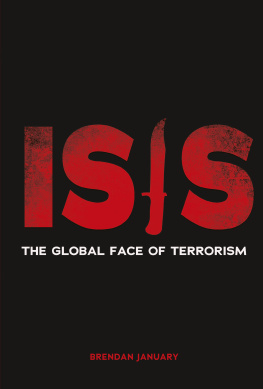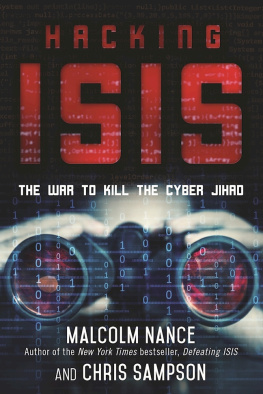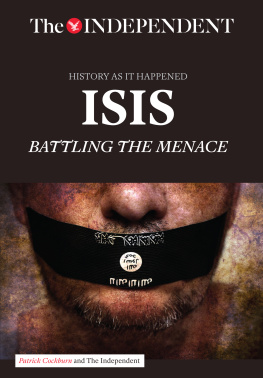Publishers Note: To keep current on ISIS, follow reputable newspapers and other sources for breaking news and consult the Further Information section on pages 99100 of this book for additional resources.
Text copyright 2018 by Brendan January
All rights reserved. International copyright secured. No part of this book may be reproduced, stored in a retrieval system, or transmitted in any form or by any meanselectronic, mechanical, photocopying, recording, or otherwisewithout the prior written permission of Lerner Publishing Group, Inc., except for the inclusion of brief quotations in an acknowledged review.
Twenty-First Century Books
A division of Lerner Publishing Group, Inc.
241 First Avenue North
Minneapolis, MN 55401 USA
For reading levels and more information, look up this title at www.lernerbooks.com.
Main body text set in Adrianna Regular 11/15.
Typeface provided by Chank.
Library of Congress Cataloging-in-Publication Data
Names: January, Brendan, 1972 author.
Title: ISIS : the global face of terrorism / Brendan January.
Description: Minneapolis : Twenty-First Century Books, [2017] | Includes bibliographical references and index.
Identifiers: LCCN 2016036951 (print) | LCCN 2016050118 (ebook) | ISBN 781512429985 (lb : alk. paper) | ISBN 781512448658 (eb pdf)
Subjects: LCSH: IS (Organization)Juvenile literature. | TerrorismReligious aspectsIslamJuvenile literature. | TerrorismMiddle EastHistoryJuvenile literature. | Islamic fundamentalismPolitical aspectsMiddle EastJuvenile literature. | TerrorismPreventionJuvenile literature.
Classification: LCC HV6433.I722 I85574 2017 (print) | LCC HV6433.I722 (ebook) | DDC 363.325dc23
LC record available at https://lccn.loc.gov/2016036951
Manufactured in the United States of America
1-41598-23505-4/12/2017
9781512467895 mobi
9781512467901 ePub
9781512467918 ePub
Contents
Nightmare in Paris
Origins
From Insurgency to Caliphate
The Kingdom of God
Looking West
The Challenge of Our Times
Nightmare in Paris
W inter was coming to the City of Light. It was Friday night in Paris, in mid-November 2015. Bars and restaurants were filled along the citys elegant streets and boulevards. In the northern part of the city, a raucous crowd packed the Stade de France to watch the French national soccer team, dressed in their royal blue jerseys, play a match against Germany. Frances president, Franois Hollande, was in the stands.
At 9:20 p.m., a French midfielder skillfully used his body to keep the ball from a German defender. Suddenly a deep, muffled bang sounded from outside the stadium. The crowd, thinking it a firework, broke into a ragged cheer. The players didnt pause in their game.
A few minutes later, in the heart of the city, a black car pulled up outside a popular bar, Le Carillon. Bar patrons inside and at sidewalk tables were enjoying drinks and meals. The peaceful scene was shattered as two men emerged from the car, leveled Kalashnikov assault rifles, and began firing.
French firefighters carry a wounded woman to safety outside the Bataclan nightclub in Paris, where ISIS jihadists killed eighty-nine concertgoers on November 13, 2015. In total, ISIS attacks in the city killed 129 and wounded more than 300 others that night.
In a terrified scramble for cover, diners pressed against the sidewalk, dropped under tables, and hid behind chairs. Rounds of gunfire snapped loudly in the onslaught. The attackers moved from Le Carillon across the street to a Cambodian noodle shop, where they continued shooting. Fourteen victims died at both restaurants.
Back at the stadium, a French defender took a pass, and another explosion sounded. This one was louder, like a huge steel door swinging shut. The crowd cheered again. But a bodyguard soon leaned over Hollandes shoulder and whispered: The country is under attack.
The explosions had come from suicide bombers. They had planned to detonate their explosive vests inside the stadium amid thousands of fans. Instead, one man detonated his bomb at the stadium gate after a security guard prevented him from entering without a ticket. The explosion killed the bomber and a passerby. An accomplice, also unable to enter the stadium, detonated his vest outside a nearby McDonalds restaurant, killing only himself. Inside the stadium, security guards surrounded Hollande and rushed him to a motorcade. Sirens flashing, the motorcade sped off to a secure, undisclosed location.
Back at Le Carillon, bodies were sprawled on the sidewalk and in the street, cut down as they tried to flee. Gunfire sounded just a few blocks south, where the team of gunmen struck another caf and then a restaurant. The restaurants outdoor terrace became a killing field. In another part of the city, gunmen attacked an eatery called La Belle quipe, killing nineteen.
At another restaurant, Comptoir Voltaire, a man nervously threaded his way among the closely spaced tables. He covered his face with his left hand and detonated a bomb strapped around his waist.
Very Calm, Very Determined
At the citys Bataclan concert hall, an American heavy metal band, Eagles of Death Metal, was performing to a packed audience of fifteen hundred. Three men carrying assault rifles forced their way into the building. Crying Allahu akbar (God is greater in Arabic), they started shooting.
The music halted, and panicked concertgoers fled to upper boxes and crawled through windows. Michael OConnor of Great Britain pulled his girlfriend toward an exit to the right of the stage. A crowd jammed the doorway. Behind the couple, the gunmen moved closer.
People [were] falling all over the place, people screaming and just clawing and running and pushing to get away, OConnor said. When the gunmen paused to reload their rifles, concertgoers dashed to the exits. But the gunmen were efficient. When he started to shoot again, we just hit the floor.... I pulled my girlfriend underneath me and I lay on top of her. I thought I was going to die, said OConnor.
Outside the hall, the staccato of automatic rifle fire drifted across the cityscape, joined by the scream of ambulances and emergency vehicles. Crumpled forms were scattered outside restaurants in ghastly positions amid overturned tables and glass windows chipped with bullet holes. Survivors, their faces etched with panic, horror, and shock, stumbled to safety. Near Le Carillon, residents threw down sheets to cover bloodied bodies in the street. Knots of police officers confronted crime scenes of unprecedented violence and savagery in a city that normally embodies elegance, beauty, and life.
Back in the Bataclan, the terrorists were very calm, very determined, recalled one concertgoer. They reloaded three or four times their weapons.... They were unmasked and wearing black clothes and they were shooting at people on the floor, executing them.
David Fritz-Goeppinger, a twenty-three-year-old Chilean-French photographer, watched one of the gunmen. He had a gun in his hands. He fired, and he fired. And he laughed. There was a sort of triumph in death.
Desperate to escape, Fritz-Goeppinger climbed out a window and hung by his arms, high above the street. A terrorist spotted him and told him to come back in. The gunman told Fritz-Goeppinger that he had just killed 100 people and one more would not make any difference.














